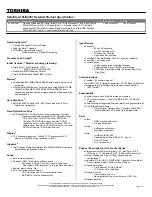
2–6
Safety & Comfort Guide
Finding Your Comfort Zone
Forearms, Wrists, and Hands
While typing or using a pointing device, keep your
forearms, wrists, and hands in their neutral comfort zone.
You are the best judge of what feels comfortable to you.
One way to find your comfort zone is to completely relax
your arms, wrists, and hands at your sides and notice how
they are positioned. When you lift them up to type, hold
them at or near these same relative positions (their
neutral comfort zone), avoiding bending your wrists
markedly up, down, in or out to the sides, especially
frequently or for long periods of time (
refer to Chapter 3, in
the section “Keyboard and Pointing Device”
). These
recommendations apply wherever you are—in the office,
at home, traveling—whether you are standing or sitting.
Do Not Anchor Your Wrists
When typing, do not anchor or rest your wrists on your
work surface, your thighs, or a palm rest (sometimes
called a wrist rest). Resting your palms while typing may
be harmful because it can cause you to bend and hold
your wrists and fingers back. It can also apply pressure to
the underside of your wrists. A palm rest is designed to
provide support during pauses, when you are not typing
(such as when you are reading from the screen).
TIP
Split keyboards
If you find it difficult
to type with a
comfortable, neutral
wrist position, you
may want to try a
split keyboard. Be
aware, however, that
improper setup or
posture while using
a split keyboard can
increase marked
bending in your
wrists. So if you try
using a split
keyboard, set it up
properly so your
forearms, wrists,
and hands are in a
comfortable, neutral
position.
AVOID!
Be sure not to rest
your wrists on sharp
edges.
RIGHT
Maintain a
comfortable, neutral
wrist position.
WRONG!
Do not rest your
palms or bend your
wrists markedly down
while typing.
















































